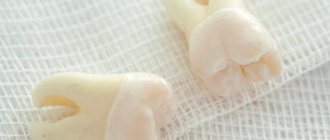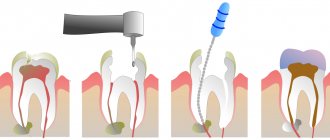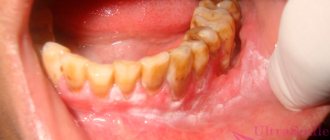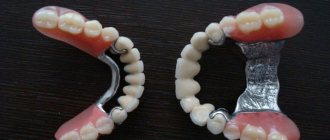What is periodontitis?
We can easily notice changes in the appearance of teeth and the appearance of carious lesions on the enamel at home, limiting ourselves to one visual examination of the oral cavity. But things are completely different when you need to know the condition of the pulp. The pulp is the heart of the tooth, which is hidden from prying eyes. To see it, you need to undergo an x-ray examination by a dentist. The same applies to the root and basal tissue of the tooth; their diagnosis is carried out only using an x-ray. Inflammation of the periodontal tissues can be fraught with dangerous consequences; if the infection penetrates deep into the tooth and goes beyond the root canals, a person may lose the tooth.
Possible problems
Treating toothache under a crown is often fraught with problems. Among them:
- The crown is installed on a pin, which must be removed during treatment. This may lead to perforation of the root, which can lead to its fracture and subsequent root removal;
- the canals are filled only after the previous filling has been completely removed, which often causes root perforation;
- After cleaning the old filling, it is necessary to undergo a course of treatment with anti-inflammatory drugs and only then can a new crown be installed.
Reasons for the development of periodontitis.
When caries begins, pathogenic bacteria begin to actively multiply and if the disease is not cured in a timely manner, the inflammatory process spreads to the enamel and affects the dentin. When the infection reaches the pulp, a complication of caries develops. It is untreated pulpitis that causes periodontitis. Once in the periodontium, the infection begins to irritate it, causing its response. This is how our body reacts to problems: the patient may experience increasing pain, which is localized and sometimes becomes completely unbearable.
It should also be noted that the formation of periodontitis is also possible under other conditions:
Poorly sealed canals.
When filling, it is important to fill the root canals tightly and correctly with the material, and for this it is necessary to determine their size using radiography. If the dentist skipped this stage and did not fill the canal, inflammation may begin in the remaining space.
Mechanical injury to the jaw or teeth.
Very often, periodontitis occurs in children, because... Little fidgets constantly fall, and sometimes they can hurt their faces, you should pay attention if your child, after such an active walk, begins to complain of severe tooth pain.
Development of infection under the crown.
In this case, periodontitis occurs due to the incompetence of the doctor, or he incorrectly carried out the preparation stage and poorly processed the tooth and filled it, or an error was made when placing the crown, and the dentist did not remove the dead pulp.
Use of arsenic.
Previously, arsenic was used to kill the pulp, if the dose is incorrectly determined and with its long-term effect on the body, there is a high risk of an inflammatory process in the periodontal area. Currently, dentists use high-quality anesthetics that allow them to treat and remove the pulp without exposure to arsenic paste.
Use of antiseptic drugs.
One of the main reasons for the development of drug-induced periodontitis is the excess concentration of drugs during filling and treatment of root canals.
Why can a tooth hurt under a crown?
The main factors causing discomfort:
- improper preparation for dental prosthetics - poor canal filling, which causes the risk of developing periodontitis;
- improper obturation of the canal - voids are left or the filling does not adhere well to the tooth;
- canal perforation – as a result of careless actions of the doctor, he can make a hole in the wall of the tooth canal.
Insufficiently tight fixation of the crown
Depressurization of the crown
Tooth decay under the crown
Symptoms and signs of periodontitis.
As mentioned earlier, periodontitis may not manifest itself for a long time; the patient runs the risk of finding out about the disease too late, when it has entered the acute stage. In this case, the signs of inflammation of periodontal tissues will be felt much more clearly. Periodontitis is characterized by the following symptoms:
Deterioration of general condition.
There is an increase in temperature, worsening sleep, weakness, etc.
- Pain when chewing food and when closing the jaws.
- Change in gum color (become darker).
Based on this symptom, periodontitis can be identified in its initial stages of development. Also, the periodontal tissues may swell, and the swelling may spread to the cheek and neck.
Painful sensations.
In the acute course of the disease, the patient begins to be bothered by a sharp, aching pain that radiates to neighboring teeth.
- Slight tooth mobility.
- The appearance of bad breath.
- Increased sensitivity due to mechanical impact on the tooth.
Treatment with medications and herbal medicine
Situations where a tooth hurts under a crown, but there is no way to quickly visit a doctor, are not uncommon. In such cases, you can slightly reduce the pain by using various medications. Among them:
- non-steroidal anti-inflammatory drugs - will reduce pain and relieve inflammation, but they cannot be taken for a long time;
- lotions using hydrogen peroxide;
- rinsing with a soda solution of 1 tsp. baking soda diluted in a glass of water.
Similar medications are prescribed after surgery to alleviate the patient’s condition and reduce pain. In addition, herbal preparations, for example, a decoction of calendula, sage, thyme, as well as chamomile or oak bark, will help reduce pain. They are used as a mouth rinse.
Types of periodontitis.
There are several classifications of periodontitis; it is usually distinguished by the place of formation: apical (infection affects the base or apex of the root) and marginal (occurs in the area of the gum edge due to injury).
According to the nature of the course of the disease, the following stages are distinguished:
Acute periodontitis.
It is further divided into several forms: serous acute periodontitis is the initial stage of the development of inflammation; it occurs after the infection penetrates through the apex of the tooth root into the periodontal area. Then it develops into purulent acute periodontitis. This form of the disease is very dangerous because The pus penetrates the bone structures and can spread throughout the body. It is characterized by: severe increasing pain, painful sensations when pressing on the tooth and when biting, headache, swelling of the mucous membrane, etc.
Chronic.
It has three stages of development: fibrous, granulating and granulomatous. Chronic periodontitis is characterized by a calm and even imperceptible course of the inflammatory process; only sometimes the patient may experience slight pain when tapping a painful tooth. But at the same time, this stage is considered the most dangerous, because may lead to tooth loss. With the development of the granulating form, the unit and the tissues around it are destroyed. A fistula forms on the gum, from which pus flows. Granulomatous periodontitis is characterized by the formation of a granuloma, a sac filled with purulent fluid, which subsequently develops into a cyst if not removed. Tooth mobility increases, gums bleed, and abscesses develop.
How to avoid pain under a crown?
It’s easy to avoid pain under the crown; you just need to follow these simple rules:
- it is necessary to have prosthetic teeth only in modern clinics with high-quality equipment and from doctors with extensive experience;
- it is important to follow all doctor’s recommendations regarding oral hygiene after dentures;
- If discomfort occurs, you should immediately consult a doctor rather than wait until a minor inflammation develops into a serious problem.
It is worth remembering that dental treatment under a crown is a complex and expensive procedure. The doctors at the One to One dental clinic understand this and do everything to prevent their patients from having such problems. Treatment and prosthetics by our specialists guarantees that you will receive high-quality services.
Treatment of periodontitis.
During the examination, the dentist will determine the degree of development of periodontitis, and the treatment plan will depend on this. Making a diagnosis is not difficult; upon visual examination of the oral cavity, one will notice severe destruction of the tooth structure, a change in the color of the gums, and there is no reaction to cold and hot water. Eliminating the consequences of inflammation of periodontal tissue can take quite a long time; you will have to visit the doctor several times. Several years ago, such a diagnosis forced doctors to remove the damaged tooth, but now the patient has the opportunity to maintain the integrity of the dentition and get rid of the inflammatory process.
Treatment of periodontitis is possible in several ways; if therapeutic methods are not effective, the dentist uses surgical intervention. Let's take a closer look at the stages of treatment:
Treatment of a damaged tooth.
First, it is necessary to open access to the root canals, remove softened dentin and remnants of infected tissue. This procedure is performed using a special bur, after which the cleaned cavity is treated with antibacterial drugs. Then the tooth canals are widened, washed with antiseptic solutions and the medicine is placed in them. Until the inflammation is stopped, the doctor has no right to proceed to the next stage.
Filling.
At the end of the treatment, the root canals are tightly filled. In most cases, these actions are enough to get rid of inflammation, the microflora of the tooth is normalized, and its tissues are regenerated.
This treatment option is a conservative method; surgical intervention is performed according to a different plan:
The operation is performed under anesthesia. In the area where the granuloma is located, an incision is made into the mucous membrane and periosteum, resection of the root apex is performed and the purulent neoplasm is cleaned out. The wound is washed with antibacterial drugs, disinfected, and sutures are applied.
If the patient's periodontitis is in the last stages of development and treatment does not have a positive effect, then a decision is made to remove the tooth.
Treatment methods in our clinic
In most cases, treatment is radical and consists of the following steps:
- Removing the old crown.
- Complete removal of old filling material.
- Eliminate the source of inflammation.
- Taking a course of anti-inflammatory therapy, which can last 2-3 months.
- Canal filling.
- Installation of a new crown.
Such therapy often costs more than conventional prosthetics.
Dental treatment under a crown
If the source of inflammation is located at the top of the root, then it is quite possible to perform a tooth root resection. It involves removing the source of pus through an opening in the bone tissue. The option is very convenient, because you do not have to undergo long-term therapy and install a new crown. However, it is not always available. This operation lasts no more than an hour and its big advantage is that it is non-traumatic.









